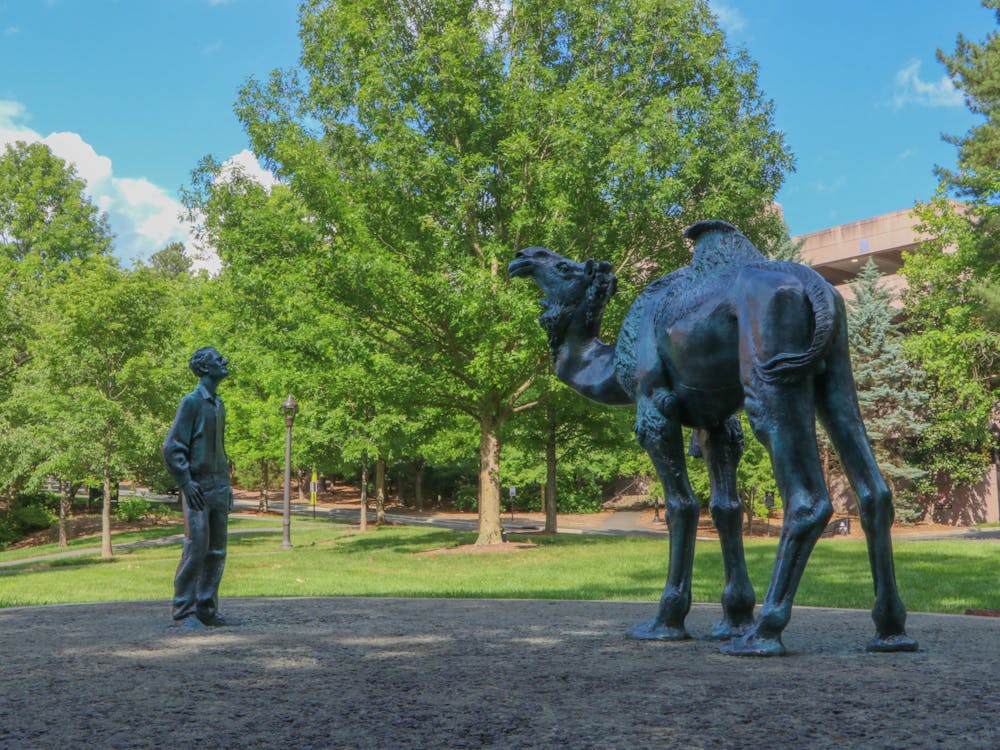Why does Duke have a statue of a camel displayed on West Campus?
The sculpture, titled “Scientist and Nature,” is located between Gross Hall and the Biological Sciences Building on Science Drive and is one of the University’s most unique landmarks, but not many students know the story behind the man it depicts.
“Scientist and Nature” was built in 1993 by British wildlife sculptor Jonathan Kingdon and dedicated in 1996 to Knut Schmidt-Nielsen, former James B. Duke professor of biology. It features Schmidt-Nielsen, one of the leading comparative physiologists of the 20th century, facing a camel as a tribute to his groundbreaking work studying animal physiology.
Cast in bronze, the landmark underwent a weeklong cleaning in May to restore its original blue hues.
Its inscription — “Tell me about yourself, Camel, that I may know myself” — embodies Schmidt-Nielsen’s novel approach to physiology.
The man behind the statue
“[‘Scientist and Nature’] is basically Knut looking at a camel and asking the camel, ‘What are you all about?’” said H. Frederik Nijhout, John Franklin Crowell distinguished professor of biology and former colleague and close friend of Schmidt-Nielsen. “That was always his mode of research — he got curious about how animals do things.”
Born in Norway in 1915, Schmidt-Nielsen rose to prominence through his work in comparative physiology. His foundational research largely focused on understanding how animals such as seagulls and camels survive in extreme environments.
In the early years of World War II, Schmidt-Nielsen and his wife fled Norway for Denmark, where he contributed to the underground Danish resistance to German occupation while continuing his research. They moved to the United States in the mid-1940s, and in 1952, Schmidt-Nielsen was appointed as a professor of physiology in Duke’s zoology department. There, he would play a central role in ushering the University into a new era of international prestige.
“He was basically the most important biologist not only at Duke, but probably in the entire United States in terms of comparative physiology,” Nijhout said. “It made the biology department quite prominent nationally and internationally … he put it on the map.”
After coming to Duke, Schmidt-Nielsen spent a year in North Africa researching the physiological mechanisms that allow camels to survive in the arid desert climate. His findings dispelled the commonplace myth that a camel’s hump enables its survival and instead revealed novel insights related to the physiology of the camel’s nose and body temperature adaptations, earning him international recognition.
Schmidt-Nielsen’s 1975 book “Animal Physiology: Adaptation and Environment” uprooted the traditional human-centric approach to physiology. His comparative approach was integrated into scientific courses across the country, “taking biology by storm,” according to Nijhout.
“After he published that book, everything changed,” Nijhout said. “… That was the very first time that anybody had published a textbook that actually did physiology in his comparative way, looking at how different animals have solved the same [survival] problem in different ways.”
Throughout his nearly 70-year career, Schmidt-Nielsen published 270 scientific papers and five books that have been translated into 16 languages. He also earned numerous awards, including the International Prize for Biology in 1992, and was elected to the National Academy of Sciences, the Royal Society and other prestigious institutions.
“[He] was always questioning ‘How do you ask the question of an animal in a way that you can actually answer it?’” Nijhout said. “… And how can we generalize that to what other organisms do?”
Schmidt-Nielsen passed away in 2007 at age 91. In 2014, faculty in Duke’s biology department gathered to rededicate the sculpture to their former colleague.
“He was just the warmest person you would ever want to meet,” Nijhout said. “We had such a great time together.”
Get The Chronicle straight to your inbox
Sign up for our weekly newsletter. Cancel at any time.
Kate Haver is a Trinity sophomore and a university news editor of The Chronicle's 120th volume.

